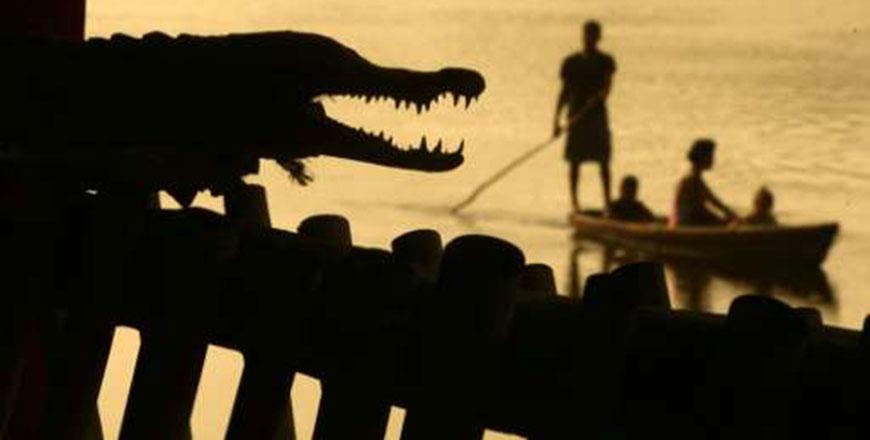You are here
Crocodile ‘nanny’ brings reptile back from brink in El Salvador
By AFP - Jul 01,2015 - Last updated at Jul 01,2015

People drive a boat past a crocodile in Barra de Santiago, 110km southwest of San Salvador, El Salvador on June 23 (AFP photo)
BARRA DE SANTIAGO, El Salvador — The hungry baby crocodiles wriggle in Jose Antonio Villeda’s hand. One by one, he squeezes open their jaws and uses a plastic tube to prod pieces of fish down their gullets.
Villeda is a park ranger working to save the local population of Crocodylus acutus, also known as the American crocodile, here in the mangroves of the Barra de Santiago nature reserve on El Salvador’s Pacific coast.
Once a common site on muddy riverbanks and in the water, numbers crashed as a result of hunting.
“They were massively sought by hunters who wanted their skin,” said Villeda, 53.
At one point in the 1980s, only five of the scaly creatures remained.
From 1990, rangers at this popular park started to monitor nesting sites of the few remaining crocs. Conservation efforts were complicated, at least initially.
About 26,000 people live on the reserve and many of the ranches and homes in the area exhibit stuffed crocodiles as trophies. Impoverished locals collect molluscs and crabs and, during nesting season, will also take crocodile eggs to eat.
Crocodile ‘nanny’
Villeda now knows a lot about crocodile reproduction, and six years ago, thanks to educational outreach efforts, locals started to bring him any eggs they found.
That’s when he took on the unusual position of being a crocodile nanny.
“Taking care of a nest with eggs is a big responsibility,” he said, explaining how the temperature affects how long it can take for the eggs to hatch — usually about 85 days.
When he hears the first squeaks of the newborn crocs, he will help them out of their eggs.
Villeda, who also owns a restaurant, buys the fish himself and typically feeds the animals from the fourth day after they hatch, and they stay in his care for about two months.
“What is gratifying is that we now have a real crocodile population. We have gone from five to more than 200,” Villeda said.
When the animals are released into the local Zapatero canal, in which seawaters mix with river water, they find themselves amid populations of other rare animals, such as the yellow-naped parrot and a type of pink spoonbill whose feathers were once massively sought for hat decorations.
On a recent boat trip, the green eyes of a few crocodiles could be seen poking above the channel’s dark waters.
The youngsters will have to fend for themselves to avoid being eaten by the adult male crocs who have already claimed the area.
Maria Henriquez, a 34-year-old ranger, holds in her hand a baby crocodile and prepares to release it.
“It’s quite moving, because we are helping nature keep this species alive,” said Henriquez, the only woman among the team of six rangers.
Villeda’s efforts were recognised by the non-governmental group Ecological Union of El Salvador, which cites his work as a good example for people to follow in a country where wildlife often suffers because of natural disasters, hunting, deforestation and pressures from a large impoverished population.
“We believe that such initiatives contribute to the conservation of our coastal marine ecosystem in danger,” said Gregorio Ramirez, a representative of the environmental group.
Related Articles
A chorus of chirps filled the room as one of the Philippines’ top crocodile breeders checked on his wards in an overcrowded ‘Noah’s Ark’ for one of the world’s most endangered animals.
PHUKET, Thailand — After laying eggs on a deserted Thai beach, a green sea turtle dives back into the turquoise-coloured waters of the Andam
AMMAN — An officer from the Royal Rangers Department was shot dead on Thursday by a man suspected of being illegally in possession of wild a

















